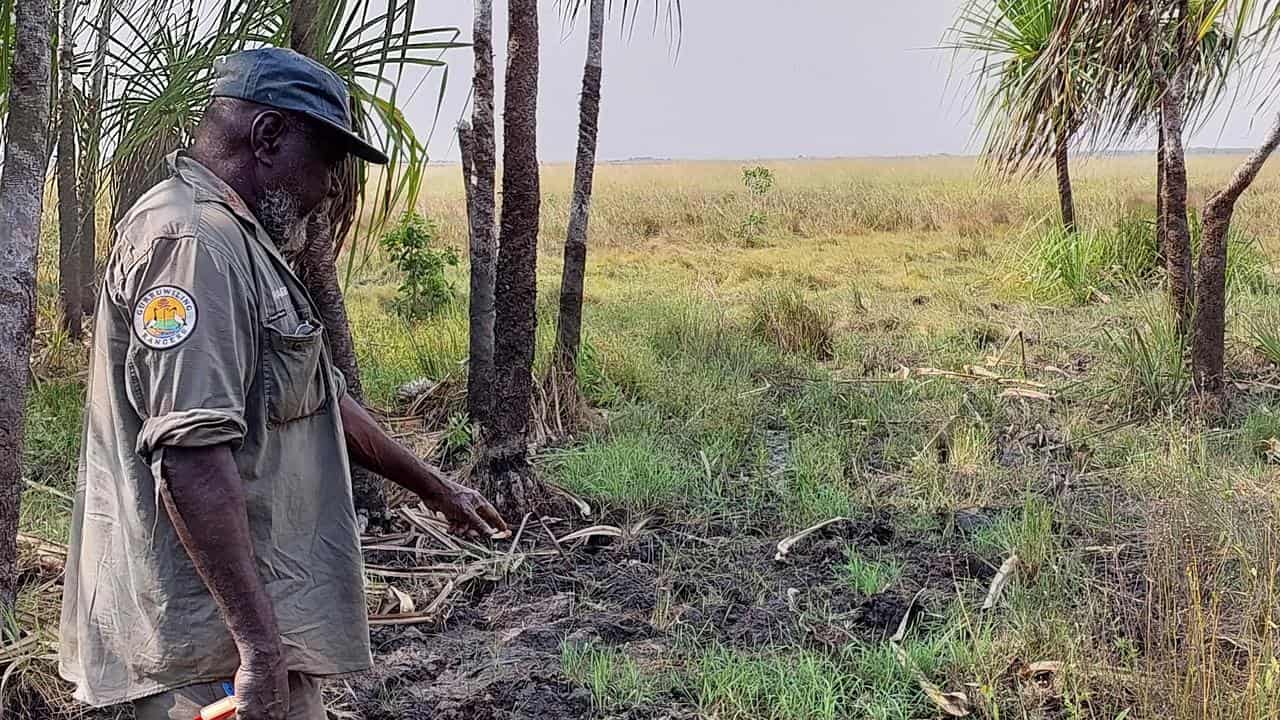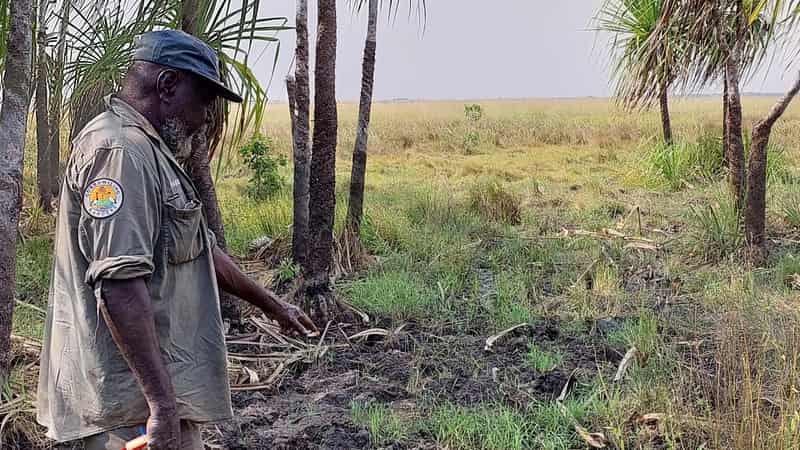
Traditional owners of the largest paperbark swamp in the country, Gurruwiling, are worried about the damage caused by feral buffalo and pigs.
Yolngu traditional owner Neville Gulaygulay is a director of the Arafura Swamp Rangers Aboriginal Corporation, based in Ramingining, and the Indigenous Carbon Industry Network.
He recently showed members of a research group some of the damage done by feral animals to his country at Warrde Swamp, part of Gurruwiling (Arafura Swamp) in northeast Arnhem Land.
“We can see damages from buffalo around here, and some out further there, there are big erosions," he said.
Gurruwiling is home to many globally and culturally important bird, turtle, snake, lizard, water lily, mollusc and freshwater fish species that also provide an important food source to local communities.
The research group is looking at ways to protect country, help mitigate some of the effects of climate change and create investment into Aboriginal-led projects.
Buffalo weigh between 450 and 1200kg and have heavy hooves, which compact the soil and disrupt natural drainage patterns by creating ‘swim channels’ that enhance saltwater intrusion into fresh water sources, like swamps.
Their overgrazing leads to soil erosion and root systems are impacted, causing loss of native plant species.
Dr Justin Perry is the research manager with the North Australian Indigenous Land and Sea Management Alliance and a member of the research group.
He told AAP the damage large pest animals are causing across the Top End is obvious when you compare areas that contain feral animals to those with exclusion zones.
"There's no cover," he said.
"The soil has been totally degraded, it's been dug up and there's hoof marks everywhere or in the case of pigs, they actually dig down about 30-40cm to get all of the things that they want to eat underneath."
Buffalo also excrete waste containing excess nutrients that further deteriorate the health of the wetland soil.
Dr Perry, ICIN science advisor Sherie Bruce and chief executive Anna Boustead joined the University of Queensland project team, led by Professor Catherine Lovelock, to conduct an initial scoping and gathering of feral ungulate (large hooved mammals) damage surveys on country.
The group is investigating ways traditional owners might benefit from pest animal management in emerging carbon and environmental markets.
The team recently spent 10 days with traditional owners and park rangers in Gagagdju (Kakadu National Park), carrying out transects to measure impacts from buffalo and pigs in wetlands.
They sampled floodplain wetland soil carbon using a soil corer, checked on floodplain ants using small pitfall trap jars, surveyed vegetation structure and composition and sampled greenhouse gas releases from wetlands using a portable gas analyser.
"This is important work to measure the impact of feral ungulates and the damage they do to country," Ms Bruce, an Arrernte and Yolgnu woman, said.
Water buffalo were imported into the NT in the 19th century as working animals and meat.
They have helped spread weeds, and have affected the nesting activity of magpie geese, which has a major impact on the natural ecosystem, and freshwater crocodiles.
Traditional owners consider feral pigs a serious problem on their country.
Not only do pigs compete for favoured traditional food resources such as lilies, water chestnuts and long-neck turtles, their rooting and digging ploughs up wetlands and watercourses, and destroys native ecosystems.
And the buffalo, like cows, sheep and goats, produce methane as a byproduct of breaking down food.
But unlike farmed animals, carbon emissions produced by feral animals are not included in Australia’s carbon accounting.
"So there's actually a source of emissions there that's not currently being counted," Ms Bousted said.
"That's a concern as well and probably something that the government needs to revisit."
This research is funded by the National Environmental Science Program to inform carbon and biodiversity accounting methods that value the management of feral ungulate species, particularly in coastal and freshwater wetland areas.
Earlier in the year, modelling from Charles Darwin University researchers found the control of feral buffaloes could be worth millions in carbon offsets, changing the economics of control programs, if the federal government changes carbon and biodiversity accounting methodologies.
But, it's not as simple as sectioning off a sensitive ecosystem and removing or culling the pest animals.
"There's also this whole piece around the cultural complexity that sits underneath each of these landscapes," Dr Perry said.
"We're saying, 'Let's just pretend that we do get a methodology up and running'.
"How do we manage those local decision making processes within the governance frameworks of each of the organisations while retaining these robust environmental outcomes, but also maximising the benefits to people on the ground?"
Dr Perry said while the incentive needs to change management of feral animals to improve biodiversity and carbon benefits, it also needs to improve the lives of traditional owners who live in the region.
"So how do we maximise the amount of work that gets done by people on the ground?" he said.
"And then, having made sure those methods can be applied without having to outsource or buy in expertise and skills, how do we also manage the values that people care about out there?
"In these parts of the country we really need to be starting with the benefits of cultural management."









